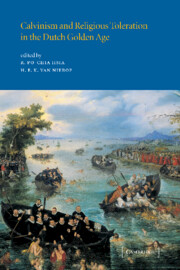Book contents
- Frontmatter
- Contents
- Notes on contributors
- 1 Introduction
- 2 ‘Dutch’ religious tolerance: celebration and revision
- 3 Religious toleration in the United Provinces: from ‘case’ to ‘model’
- 4 The bond of Christian piety: the individual practice of tolerance and intolerance in the Dutch Republic
- 5 Religious policies in the seventeenth-century Dutch Republic
- 6 Paying off the sheriff: strategies of Catholic toleration in Golden Age Holland
- 7 Sewing the bailiff in a blanket: Catholics and the law in Holland
- 8 Anabaptism and tolerance: possibilities and limitations
- 9 Jews and religious toleration in the Dutch Republic
- 10 Religious toleration and radical philosophy in the later Dutch Golden Age (1668–1710)
- 11 The politics of intolerance: citizenship and religion in the Dutch Republic (seventeenth to eighteenth centuries)
- Select bibliography
- Index
9 - Jews and religious toleration in the Dutch Republic
Published online by Cambridge University Press: 08 July 2009
- Frontmatter
- Contents
- Notes on contributors
- 1 Introduction
- 2 ‘Dutch’ religious tolerance: celebration and revision
- 3 Religious toleration in the United Provinces: from ‘case’ to ‘model’
- 4 The bond of Christian piety: the individual practice of tolerance and intolerance in the Dutch Republic
- 5 Religious policies in the seventeenth-century Dutch Republic
- 6 Paying off the sheriff: strategies of Catholic toleration in Golden Age Holland
- 7 Sewing the bailiff in a blanket: Catholics and the law in Holland
- 8 Anabaptism and tolerance: possibilities and limitations
- 9 Jews and religious toleration in the Dutch Republic
- 10 Religious toleration and radical philosophy in the later Dutch Golden Age (1668–1710)
- 11 The politics of intolerance: citizenship and religion in the Dutch Republic (seventeenth to eighteenth centuries)
- Select bibliography
- Index
Summary
The Dutch Republic has been famed as a tolerant haven in an intolerant confessional Europe. The limits and peculiarities of this toleration are equally well known. In the first place, there were stark regional differences. Most representations of Dutch tolerance rest upon the example of the western and maritime province of Holland. The religious order of other provinces, like Overijssel or Groningen, was much closer to the model of the German Landeskirchen, while the closest parallel for the religious regime of the Generality Lands is probably to be found in eighteenth-century Ireland. In these areas in the south, conquered by the armies of the Republic in the later stages of the Eighty-Years' War, a mainly rural Catholic population was governed by a small elite of Reformed office-holders on behalf of the States-General. Even within Holland, there were marked differences between the religious policies of the various cities, with Amsterdam and Rotterdam, for instance, being more tolerant than Haarlem and Leiden. In the second place, Dutch tolerance was not founded upon an ideology. Tolerant policies were a mixture of sentiment, tradition, and expediency. There were, of course, ideological debates about toleration within the Dutch Republic, but it is rather difficult to relate them to the actual practices of toleration. It is particularly hard to get a clear picture of what kind of social and religious order the defenders of tolerance actually had in mind.
- Type
- Chapter
- Information
- Calvinism and Religious Toleration in the Dutch Golden Age , pp. 132 - 147Publisher: Cambridge University PressPrint publication year: 2002



